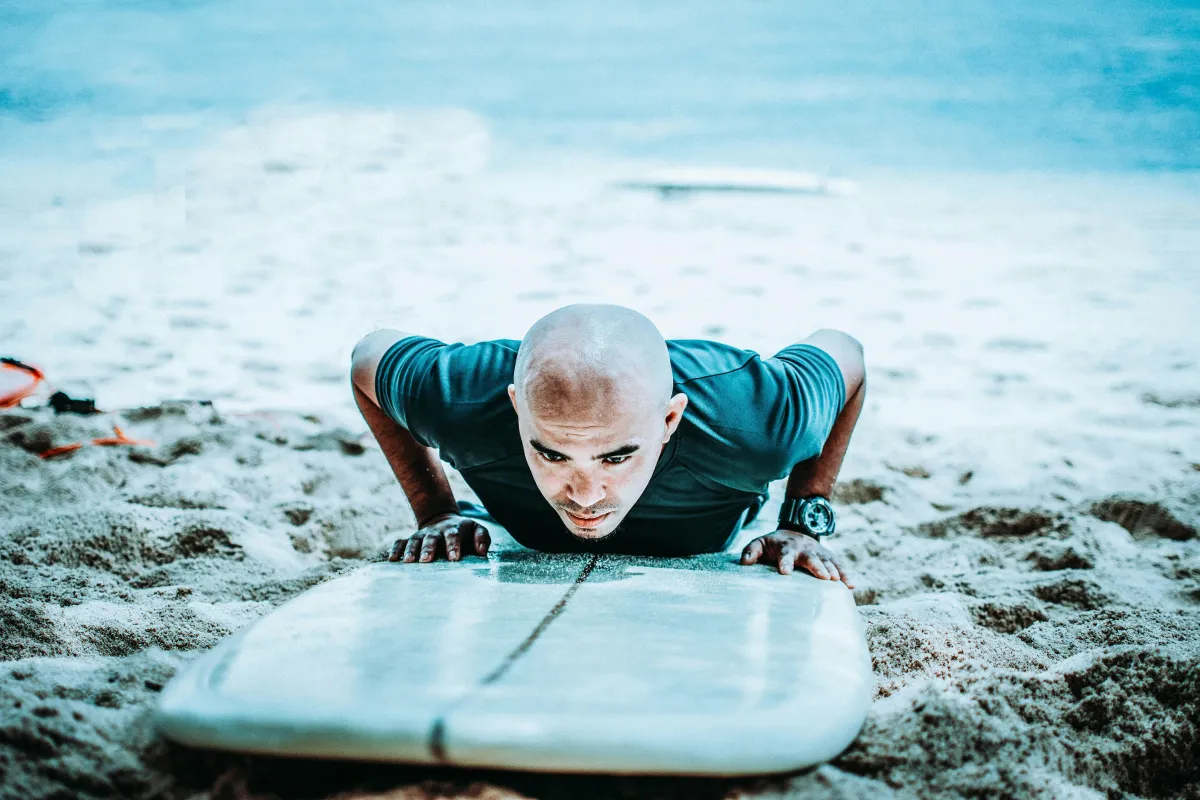
The 45-Minute Solution: Why Two Gym Sessions Beat Endless Surf Fitness
How the minimal effective dose approach transforms your surfing while everyone else spins their wheels
You’ve seen them at the beach—the surfers who seem to train constantly but never actually get stronger. They’re doing burpees on the sand, endless paddle sessions, and whatever “surf-specific” exercise they saw on Instagram last week.
Meanwhile, you’re left wondering why your own random collection of workouts isn’t translating to better surfing.
Here’s the uncomfortable truth:
Random training produces random results.
In a world obsessed with “more is better,” the most powerful training principle might be the one you’ve never considered: the minimal effective dose.
The Problem with Random Training
Let’s paint a picture that might sound familiar:
Monday: You do a “surf conditioning” workout you found online
Wednesday: You try some yoga because flexibility is important, right?
Friday: You hit the gym and do whatever feels good that day
Sunday: You give some “core for surfers” exercises a shot
This isn’t training. It’s exercise roulette.
Research shows that random training leads to:
Inconsistent adaptation
Higher injury risk
Mental fatigue from decision-making
No progressive overload
Poor skill acquisition
Most surfers never stick with anything long enough to move past the early learning phase—so they never see real results.
The Science of Adaptation: Why Your Body Needs Predictability
Adaptation follows a predictable timeline:
Weeks 1–2: Neural adaptations
Weeks 3–4: Strength gains accelerate
Weeks 4–6: Muscle growth contributes to strength
Weeks 6–8: Structural adaptations solidify
Weeks 8+: Advanced improvements occur
Change your workout every couple of weeks and you’re constantly restarting that timeline.
The Minimal Effective Dose (MED)
The minimal effective dose is the smallest amount of training that produces meaningful results.
Studies show that:
Just 1–3 weekly sets can drive strength gains
6–10 sets per muscle group weekly maintains muscle
Training twice per week delivers more growth than once
3–6 sets of heavy reps in compound lifts create real strength
For surfers, this means:
Two focused 45-minute gym sessions per week > hours of random surf fitness.
Why 45 Minutes Is the Sweet Spot
Hormonal Response: Long sessions spike cortisol
Focus & Quality: Attention drops after 45 minutes
Recovery: 72 hours between sessions = optimal adaptation
Sustainability: 45 minutes fits busy schedules
The Two-Session Solution: Sample Program
Session 1: Foundation Strength
Squat variation – 3x5–8
Pull-up/Row – 3x5–8
Push-up/Press – 3x5–8
Single-leg – 2x8–12 per leg
Anti-rotation core – 2x30–45 secs
Session 2: Power & Integration
Explosive squat – 4x3–5
Explosive pull – 4x3–5
Loaded carry – 3x20–40m
Movement integration – 2x5–8
Mobility – 5–10 mins
Total weekly time: 90 minutes
Why Boring Beats Exciting
The most effective training is often repetitive:
Consistency beats intensity
Repetition builds skill
Habit formation requires structure
The surfer who trains twice a week consistently will always outperform the one who constantly switches programs.
The Program Hopping Trap
Typical pattern:
Weeks 1–2: Excitement
Weeks 3–4: Plateau
Weeks 5–6: See new program
Weeks 7–8: Switch
Repeat
You never get past basic neurological gains. Real strength never develops.
The Adaptation Timeline
PhaseTimelineGainsFeelNeural learningWeeks 1–210–15%Form improvesNeural optimisationWeeks 3–415–25%Movements smootherStructural changeWeeks 4–620–30%Visible muscle gainsHypertrophyWeeks 6–825–35%Strength & size increasesAdvanced adaptationsWeeks 8–1230–40%+Noticeable power in water
The Compound Effect
Small, consistent progress adds up fast:
Week 1: 3 pull-ups
Week 4: 5 pull-ups
Week 8: 8 pull-ups
Week 12: 12 pull-ups
That’s a 300% improvement—from consistency, not complexity.
Why Most “Surf-Specific” Training Isn’t
True surf-specific training means:
Functional movement
Matching energy demands
Progressive overload
Repeatable consistency
Not BOSU balls, tennis balls, or circus tricks.
The Time-Poor Surfer’s Advantage
While others burn out doing daily workouts:
You train 2x/week, follow a system, recover fully, and progress.
Structure Reduces Decision Fatigue
No more:
“What should I train today?”
Structured programming means:
No guesswork
Mental clarity
More energy for execution
Recovery = Results
Training is the stimulus. Recovery is where the adaptation happens.
48–72 hrs = ideal strength recovery
Sleep > volume
Stress & nutrition matter more than you think
Two sessions/week = full recovery = more results.
Progressive Overload: The Only Way Forward
No overload = no improvement.
Random workouts = no progression
Structured training = trackable progress
Simple.
Why Strength Is the Foundation
Every athletic quality—power, endurance, movement, skill—starts with strength.
For surfers:
Paddle power = upper body strength
Pop-ups = pushing power & hip mobility
Wave riding = core & leg strength
How to Apply the 45-Minute Solution
Pick 2 days/week
Master basic movements (squat, hinge, push, pull, carry)
Progress gradually
Track everything
Be patient – Give it at least 8 weeks
Play the Long Game
Random training:
Year 1: Plateau
Year 3: Injuries
Year 5: Burnout
MED approach:
Year 1: Gains
Year 3: Strength
Year 5: Long-term performance
What the Research Says
✅ Greater adherence
✅ Lower injury risk
✅ Better recovery
✅ Higher performance
✅ Sustainable long-term
Your Next Session Starts Now
Stop chasing trends.
Start building a system that actually works.
2 sessions/week
45 minutes each
Track it
Progress it
Stick with it
Give it 8 weeks. Then watch your surfing transform.
At Surf Performance Systems, we’ve spent 15+ years helping surfers train smarter.
If you're ready to stop guessing and start progressing — this is your solution.